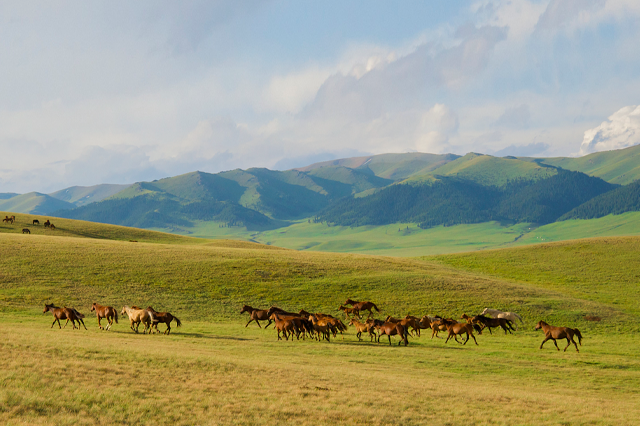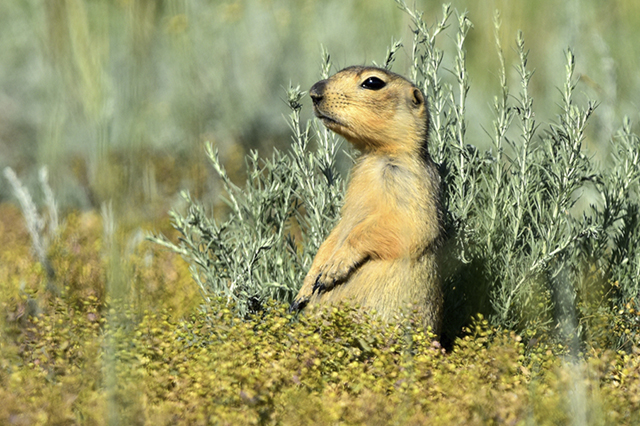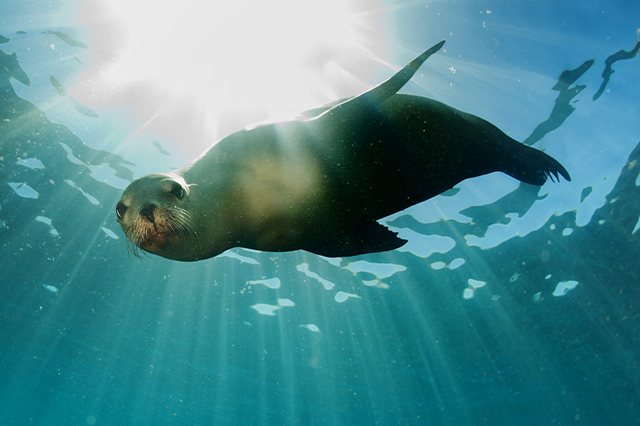Natural features of Ulytau
The Ulytau region of Kazakhstan is a unique and ecologically diverse area located in the central part of the country. The region covers an area of about 42,000 square kilometers and is characterized by a great diversity of habitats, including mountains, steppes, and semi-deserts. This diversity of habitats has led to the development of unique flora and fauna, well adapted to the region's harsh climatic conditions.
This region is home to numerous plant species, many of which are found only in this region. The Ulytau region's steppe vegetation is characterized by grasses, herbs, and shrubs (feather grass, sagebrush). The region is also famous for wild tulips, a symbol of the natural heritage of Kazakhstan.
The Ulytau region also has diverse fauna, including many rare and endangered species. One of the most iconic species inhabiting the area is the Turanian tiger, also known as the Caspian tiger. This tiger subspecies was once widespread throughout Central Asia but became extinct in the wild in the 1970s due to hunting and habitat loss.
Other known species in the Ulytau region include the saiga, an endangered species well adapted to the region's arid steppes, and the steppe eagle, a migratory bird of prey that nests during its breeding season. The area is also home to various reptiles and small mammals, including marmosets, hedgehogs, and different species of lizards.
The natural heritage of the Ulytau region is an integral part of Kazakhstan's cultural identity, and efforts are being made to protect and preserve the region's flora and fauna for future generations.
Zholbarys. A predator has gone into history.
The Turanian tiger was once one of Central Asia's most iconic and majestic animals. The tiger needed a source of water. One of the main habitats of tigers on the northern border of their range was Lake Balkhash, the shores of the Amu Darya River.
Now there are repeated calls to return the Turanian tiger to the Ulytau region of Kazakhstan, where it once roamed.
While this may seem like an excellent opportunity for restoration, it also comes with several challenges that need to be addressed.
[Footnote: Evidence of Caspian tigers being massive (up to 224 cm long and weighing up to 240 kg) and hardy: the animals could easily travel up to 100 km a day.]
The main factor was hunting, which people carried out for various reasons, such as sport, fur trade, and livestock protection. Habitat loss due to deforestation and agricultural expansion also played a role in the tiger's demise. Climate change exacerbates both factors and may pose an additional challenge to attempts to return the tiger to the wild.
Despite this, there is still hope for the Turanian tiger. There have been several successful programs aimed at returning large carnivores to their natural habitat, which may be an example of the recovery of the Turanian tiger.
Global practices of large carnivores reintroduction
One example is the reintroduction of the Amur tiger in Russia. The Amur tiger was on the verge of extinction in the 1940s due to habitat loss and hunting, but a successful reintroduction program in the 1980s and 1990s led to an increase in the population. Today the population of the Amur tiger in Russia is estimated at 540 individuals.
The program included several key strategies:
-
Habitat restoration. Efforts were made to restore the Amur tiger's natural habitat, which had been destroyed by logging and other human activities. The Russian government has instituted strict regulations to protect the Amur tiger habitat and prevent further habitat loss.
-
Strict Conservation Measures. The Russian government has taken stringent anti-poaching measures to protect the Amur tiger from illegal hunting. The government has also created a national park and several protected areas for the Amur tiger.
-
Captive breeding programs. Captive breeding programs were created to increase the number of Amur tigers in the wild. In carefully controlled programs, tigers were bred in captivity and released into the wild.
According to the TASS news agency, the cost of the Amur tiger reintroduction program in Russia is estimated at 1 billion rubles (approximately $13.7 million) per year. This includes costs for habitat restoration, conservation measures, and captive breeding programs.
Another example is the reintroduction of the Iberian lynx in Spain. The Iberian lynx was on the verge of extinction in the early 2000s due to habitat loss and hunting, but a successful reintroduction program increased the population. The program's success was due to a comprehensive approach: efforts were made to restore the Iberian lynx's natural habitat, strict conservation measures, including combating poaching and illegal hunting, and captive breeding programs were established to increase numbers. Today, the population of the Iberian lynx in Spain is estimated at around 1,000 individuals.
According to a European Commission report, the cost of the Iberian lynx reintroduction program in Spain is estimated at 90 million euros (approximately $108 million) over ten years. This includes costs for habitat restoration, conservation measures, and captive breeding programs.
A third example is the reintroduction of the gray wolf in the United States. The gray wolf was eradicated from the western United States in the early 1900s, but a successful reintroduction program in the 1990s increased the population. Today, the gray wolf population in the United States is estimated at 6,000 individuals.
The program included key strategies similar to those implemented in the Spanish and Russian programs: habitat restoration, strict conservation measures, and captive breeding programs.
According to a U.S. Fish and Wildlife Service report, the cost of the gray wolf reintroduction program in the United States is estimated at $3.5 million per year. This includes the cost of habitat restoration, conservation measures, and captive breeding programs.
These estimates are not exhaustive and may not include all costs associated with each program. In addition, the cost of reintroduction programs can vary widely depending on specific program goals and strategies.
These programs provide valuable lessons for Turanian tiger recovery. They emphasize the importance of habitat restoration, rigorous conservation measures, and community involvement in conservation efforts. By studying successful programs and adapting them to the specific needs of the Turanian tiger, this iconic species can be successfully reintroduced in the Ulytau region of Kazakhstan.
Is it possible to bring back the striped predator?
If the Turanian tiger is reintroduced to the Ulytau region, it will positively impact the local ecosystem. The presence of the tiger would help control the population of herbivores, such as deer, and this would lead to a revival of plant life. This will benefit the tiger and other species that depend on a healthy ecosystem.
There are potential problems for reintroduction. The Ulytau region has undergone significant changes since the tiger last lived here, and the habitat may not meet the needs of the tiger. In addition, the area is inhabited by people, and any reintroduction must consider the impact on local communities.
Another concern is the need to protect the tiger from hunting and poaching. This will require strict conservation measures and law enforcement to ensure the tiger is not hunted and killed for fur or other reasons.
It is also essential to consider the potential impact of climate change on tiger reintroduction. Central Asia is already experiencing the effects of climate change with rising temperatures and changing precipitation patterns. These changes may have affected the availability of prey to the tiger as well as the tiger's ability to adapt to changing conditions.
Scientific research has shown that tigers living in Central Asia have genetic features identical to those in the Russian Far East. So the idea arose to reintroduce the extinct tiger population to the region.
The project, initiated by Russia's World Wildlife Fund (WWF), received support from the Kazakh government in 2010. But before starting the program, additional scientific research was needed to identify potential sites for the return of predators and to study the results of reintroduction under different scenarios. In September 2017, a Memorandum was signed between WWF and the Government of Kazakhstan on implementing a tiger recovery program in Kazakhstan.
A new home for the tiger
Kazakhstan's system of specially protected natural areas has been enlarged with the new Ile-Balkhash reserve, created on June 27, 2018. The reserve covers an area of more than 415 thousand hectares. It includes different types of natural landscapes, including the Ili River delta, saxaul forests, and wetlands on the southern shore of Lake Balkhash.
The main goal of the reserve is to restore an ecosystem capable of providing habitat for the tiger. The reintroduction program also includes activities to protect wildlife and restore populations of ungulate animals, such as riparian deer, roe deer, and wild boar, which are the main prey for tigers. Work is also underway to increase the numbers of other animals, such as kulan, saiga, and gazelle.
The first Amur tigers are scheduled to enter the reserve in 2024. According to scientists, up to 150 tigers can live in Kazakhstan in 50 years.
Establishing a minimum sustainable population of tigers will take at least 10 years, and the program's first ten years will cost 15-20 million euros. The program will be financed from the budget of the Republic of Kazakhstan and WWF partners and donors.
Conclusion
The return of the Turanian tiger to Kazakhstan's Ulytau region presents both opportunities and challenges. Despite the potential benefits of tiger reintroduction, such as restoring the local ecosystem and preserving the once iconic species, serious problems also need to be addressed. These include providing the tiger with suitable habitat, protecting it from hunting and poaching, and mitigating the potential effects of climate change. Nevertheless, with careful planning and implementation of conservation measures, it is possible to successfully return the Turanian tiger to its former home in the Ulytau region.
Source: World Wildlife Fund (WWF)




















